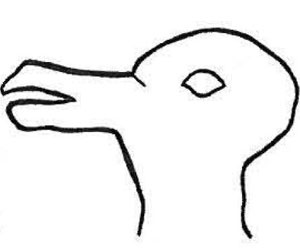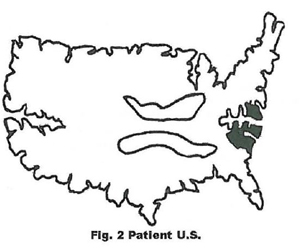Presidential Column
Reality Monitoring
My Presidential columns will feature a series of reflections and illustrations of collaborations that bridge areas within psychological science and between it and other sciences. Last month, I reflected on the virtues and perils of such bridging research. This month, Marcia Johnson suggests that cross-area collaborations can deepen our micro-understanding and broaden our macro-understanding of how people monitor the sources of information.
– Susan Fiske
APS President
2002-03

Figure 1
In Figure I, you may see the duck and I may see the rabbit. What is the “reality”? As a freshman, the idea that our minds may construct different realities seemed to me a profound insight into the human condition (it still does). As new assistant professors, John Bransford and I investigated such constructive processes. For example, after hearing short stories such as “It was late at night when the phone rang and a voice gave a frantic cry. The spy threw the secret document into the fireplace just in time since thirty seconds longer would have been too late,” research participants were likely to falsely recognize such tacit implications as “the spy burned the secret document.” Such false memories are not simply paraphrases of the original; people claim to have heard information that was not necessarily true (e.g., the fire may not have been lit and the spy may have intended to hide rather than destroy the document).
As part of normal comprehension, people construct a model of the situation, drawing on general world knowledge about objects in the environment, people’s intentions and actions, etc. In doing so, they run the risk of importing new information.
But something nagged at me about this vision of cognition and memory. Isn’t there as much danger in naïve constructivism as in naive realism? It may be okay to remember a duck or a rabbit, but there certainly was no elephant! What keeps us from careening into a dysfunctional land of fabrication?
Carol Raye and I, and many wonderful collaborators, began to investigate what we called “reality monitoring” the psychological processes by which people discriminate real from imagined events. Related research includes Beth Loftus and colleagues’ work on eyewitness testimony, Larry Jacoby and colleagues’ work on misattributions of familiarity, and Mike Ross and colleagues’ work on implicit theories.
There are now many studies from many labs exploring reality monitoring and, more generally, source monitoring, clarifying the factors that influence false memories (e.g., similarity among sources, associative and schema effects, emotional focus, the criteria adopted during remembering, etc.). This work provides a theoretical grounding for understanding individual differences in susceptibility to false memories and beliefs (e.g., in explicating the effects of imagery proneness, self-focus, anxiety, susceptibility to social influence, impulsivity).
Neuropsychological observations provide striking evidence for how dependent we are on the smooth functioning of particular brain regions in everyday reality monitoring. For example, patients with frontal lobe damage sometimes exhibit confabulations ranging from the relatively mundane to the quite bizarre. Further, frontal damage is sometimes accompanied by an unawareness of deficit (anosognosia), or a casual disregard for a recognized deficit (anosodiaphoria). Cognitive neuroscientists are now using neuroimaging techniques to identify in healthy participants brain areas associated with identifying the source of memories or areas where neural activity is similar or different for true and false memories
Just as a neurobiological perspective (inviting a more micro level of analysis, and collaborations bridging neuroscience) should deepen our understanding of reality monitoring, a social/cultural perspective (inviting a more macro level of analysis, and collaborations bridging sociology, political science, economics, media studs, law, and others) should broaden our understanding of reality monitoring.
Individual reality monitoring occurs within a social/cultural context that helps determine what information/evidence should be considered, the criteria for evaluating it, and what an acceptable error rate is. For example, the impact of salient beliefs held by an individual’s network of family and friends would be a rich domain for studying aspects of reality monitoring within social groups.
 At yet another potentially interesting level of analysis, organizations and institutions (the media, courts, universities, etc.) serve a critical reality monitoring function in our culture, involving experts and professionals such as doctors, therapists, journalists, auditors, detectives, lawyers, judges, scientists, and educators. These institutions are our cultural frontal lobes. Do we have an acceptable rate of reality monitoring failures in our social organizations and institutions? Or do we, so to speak, have lesions in our cultural frontal lobes? (Figure 2 shows a schematic brain scan of patient U.S., who has bilateral damage in the Washington, DC area, near the Congressional sulcus, with somewhat greater lesions on the right than the left. Patient U.S. shows characteristic symptoms — perseveration, lack of flexibility, grandiosity, confabulation, and unawareness of deficit.)
At yet another potentially interesting level of analysis, organizations and institutions (the media, courts, universities, etc.) serve a critical reality monitoring function in our culture, involving experts and professionals such as doctors, therapists, journalists, auditors, detectives, lawyers, judges, scientists, and educators. These institutions are our cultural frontal lobes. Do we have an acceptable rate of reality monitoring failures in our social organizations and institutions? Or do we, so to speak, have lesions in our cultural frontal lobes? (Figure 2 shows a schematic brain scan of patient U.S., who has bilateral damage in the Washington, DC area, near the Congressional sulcus, with somewhat greater lesions on the right than the left. Patient U.S. shows characteristic symptoms — perseveration, lack of flexibility, grandiosity, confabulation, and unawareness of deficit.)
We are often unaware of the importance of individual reality monitoring processes until they fail, as in schizophrenia, or cases of brain damage. The same is true at the social/cultural level. Yet we can tell we count on these institutions by our surprise, shock, or despair when their reality monitoring mechanisms do fail, when we hear revelations of fictitious or composite stories reported as news, reports of fraud in science, perjured testimony by police officers, or of failures in accounting illustrated in the recent collapse of Enron.
What mechanisms support or maintain the norms for collecting, evaluating, and/or reporting information in these various institutional domains? For example , there are credentialing procedures for getting to participate in our cultural reality monitoring apprenticeships, journalism schools, professional programs, licensing exams, and so forth — which transmit the meta knowledge and reality monitoring criteria that are to be applied along with specific domain knowledge. Are these mechanisms healthy or dysfunctional?
Considering such issues clearly raises the problem of values. For example, protecting the right of someone to call something a duck when it seems perfectly obvious that it is a rabbit is part of the “free press” rationale for tolerating tabloid journalism (a form of cultural anosodiaphoria). It has been suggested that untrue reports of recovered memories of child sexual abuse, or of ritual abuse or alien abductions come disproportionately from clients of a relatively few therapists — in effect “tabloid therapists” — using low interpersonal and within-profession criteria for reality monitoring. Of course, we also have tabloid scientists, tabloid lawyers, and so on. And it appears that Arthur Anderson is the National Enquirer of auditing firms.
Within-profession mechanisms for reality monitoring include “best practice” guidelines, professional workshops, and articles in professional journals pointing to potential sources of error. Nevertheless, for many members of our cultural reality monitoring institutions, what gets their attention are the court cases that have implications for them — that is, cross-institution reality monitoring (e.g., suits involving therapists, journalists, CEOs). Do we place too much burden on the courts for reality monitoring that should take place at other levels? Are the courts the best place for separating out fact and fantasy in some of the areas they are asked to adjudicate?
A consideration of individual reality monitoring processes suggests a healthy skepticism about one’s own memory; a consideration of social/cultural reality monitoring processes suggests a healthy skepticism about the media, courts, government, universities, even science. But in all of these domains, an unhealthy skepticism would be as counterproductive as no skepticism at all. We cannot function either as individuals or as a culture without intact reality monitoring mechanisms that we can assume work.
Can we improve our mechanisms of cultural reality monitoring without sacrificing values such as freedom of expression, open access to professions, an adversarial court system, and free enterprise? Can we distinguish between normal reality monitoring errors at the social/cultural level and more serious signs of “pathological” breakdown?
Discriminating the origin of memories, knowledge and beliefs — reality monitoring and, more generally, source monitoring — presents intriguing research questions at a number of levels of analysis and many opportunities for collaborating across domains of expertise to identify both general principles and domain specific mechanisms of reality monitoring.





APS regularly opens certain online articles for discussion on our website. Effective February 2021, you must be a logged-in APS member to post comments. By posting a comment, you agree to our Community Guidelines and the display of your profile information, including your name and affiliation. Any opinions, findings, conclusions, or recommendations present in article comments are those of the writers and do not necessarily reflect the views of APS or the article’s author. For more information, please see our Community Guidelines.
Please login with your APS account to comment.